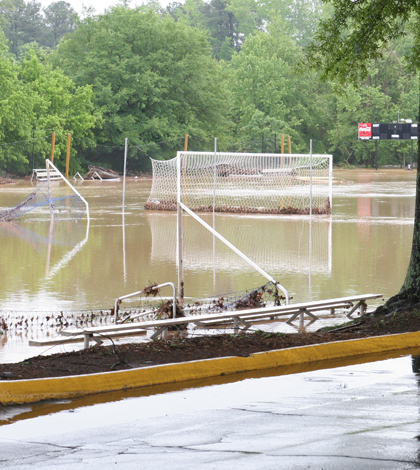Stream gauges keep Atlanta school’s students safe and educated

The creek that flows through the Marist School’s Atlanta campus is an educational asset, even if it is prone to flash floods that wreak a little havoc on school grounds.
“In ’09 when we had really bad flooding, it picked up a dumpster and dumped it 500 feet down the creek,” said Amelia Luke, a teacher and director of sustainability at the Catholic high school. “It’s still there. We can’t get the dumpster out.”
Luke, who was a student at the Marist School in the late ’90s, said she remembers when Nancy Creek would flood the grounds almost every time it rained. Drainage upgrades have made those events less common, but the creek is still capable of rearing up and making a mess of things.
The school recently opened a second section of their campus on the other side of the creek, making a priority of developing a plan to anticipate floods. To that end, a system of stream gauges now broadcasts live data on the creek’s height, giving faculty and staff warning when rising flood waters mean it’s time to evacuate vulnerable buildings and clear the grounds of debris that might wash into the creek. The system has also become an educational tool for the students and an outreach tool for the community.
The creek and the stream gauge are especially important for Luke. She co-teaches the school’s environmental science classes.
“When I took over those classes, they were taught primarily inside, which I just find ridiculous because we have such a great campus for being outdoors,” Luke said. “We have a nice little beach on our property that has easy access to the creek, and we’re down there all the time.”
The creek gives students a chance to get their hands dirty with water quality testing and macroinvertebrate surveys. Though the creek has something of a bacteria problem, Luke said the macroinvertebrates they’ve collected suggest that the creek is reasonably healthy for an urban stream.
Even the floods are eye-opening for students, Luke said. They visit the stream often enough to notice a clear difference in the shape of the beach after the high water recedes.
“Every time it floods you can see the deposition of sediment,” Luke said.” It’s a real life lab for the kids, for them to see erosion and all of that stuff.”
It’s not just the science classes, either. The creek has become the setting for English and religion classes too, Luke said. That’s a change from when she was a Marist student.
“It just used to be that thing over there on the edge of campus. Now it’s become an asset to the school.”
Top image: Nancy Creek tops its banks and covers the Marist School soccer fields





0 comments